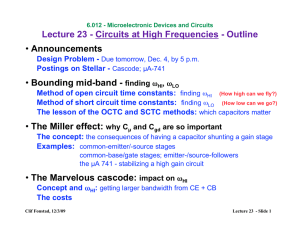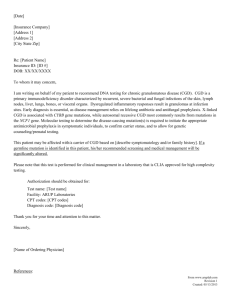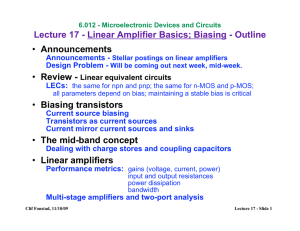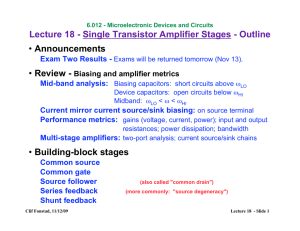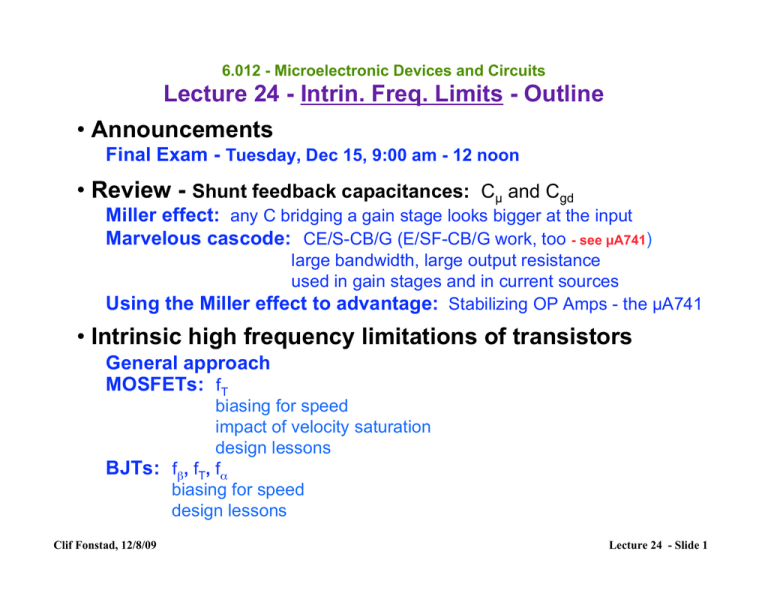
6.012 - Microelectronic Devices and Circuits
Lecture 24 - Intrin. Freq. Limits - Outline
• Announcements
Final Exam - Tuesday, Dec 15, 9:00 am - 12 noon
• Review - Shunt feedback capacitances: Cµ and Cgd
Miller effect: any C bridging a gain stage looks bigger at the input
Marvelous cascode: CE/S-CB/G (E/SF-CB/G work, too - see µA741)
large bandwidth, large output resistance
used in gain stages and in current sources
Using the Miller effect to advantage: Stabilizing OP Amps - the µA741
• Intrinsic high frequency limitations of transistors
General approach
MOSFETs: fT
biasing for speed
impact of velocity saturation
design lessons
BJTs: fβ, fT, fα
biasing for speed
design lessons
Clif Fonstad, 12/8/09
Lecture 24 - Slide 1
Summary of OCTC and SCTC results
log |A
vd |
Mid-band Range
!LO
!b
!a !d
!c
!LO *
!HI * !HI
!4
log !
!5 !2!1 !3
• OCTC:
1.
2.
3.
an estimate for ωHI
ωHI* is a weighted sum of ω's associated with device capacitances:
(add RC's and invert)
Smallest ω (largest RC) dominates ωHI*
Provides a lower bound on ωHI
• SCTC:
1.
2.
3.
an estimate for ωLO
ωLO* is a weighted sum of w's associated with bias capacitors:
(add ω's directly)
Largest ω (smallest RC) dominates ωLO*
Provides a upper bound on ωLO
Clif Fonstad, 12/8/09
Lecture 24 - Slide 2
The Miller effect (general)
Consider an amplifier shunted by a capacitor, and consider
how the capacitor looks at the input and output terminals:
Cm
+
vin
-
Av
iin = Cm
+
!vin
-
+
vout
d [(1" Av )v in ]
dt
(1-Av)Cm
Cin looks much
bigger than Cm
(1-Av)vin
iin +
+
+
vin Cm vout = A vvin
= (1" Av )Cm
Cm
dv in
dt
Note: Av is negative
+
vout
-
Cm
(1" Av )
Av
# Cm
Cout looks like Cm
Clif Fonstad, 12/8/09
Lecture 24 - Slide 3
!
The cascode when the substrate is grounded:
High frequency issues:
L.E.C. of cascode: can't use equivalent transistor idea here
because it didn't address the issue of the C's!
ro2
Cgd1
g1
+
vgs1
gm1vgs1
s1,b1,b2
Cgs1
ro1
Voltage gain ≈ -1 so
minimal Miller effect.
d2
+
d1,s2,b2
-
(gm2+gmb2 )vgs2
Cgd2 +Cbd2
Cdb1 +Cgs2 +Cbs2
vgs2
+
s1,b1,g2,b2
vout
rl
g2,b2
Voltage gain ≈ gmrl,
without Miller effect.
Common-source gain without the Miller effect penalty!
Clif Fonstad, 12/8/09
Lecture 24 - Slide 4
Multi-stage amplifier analysis and design: The µA741
Figuring the circuit out:
Emitter-follower/
common-base "cascode"
differential gain stage
EF
CB
The full schematic
© Source unknown. All rights reserved.
This content is excluded from our Creative Commons license.
For more information, see http://ocw.mit.edu/fairuse .
Current mirror load
Push-pull
output
Simplified schematic
Darlington commonemitter gain stage
Clif Fonstad, 12/8/09
© Source unknown. All rights reserved.
This content is excluded from our Creative Commons license.
For more information, see http://ocw.mit.edu/fairuse.
Lecture 24 - Slide 5
Multi-stage amplifier analysis and design: Understanding the µA741
input "cascode"
Begin with the BJT building-block stages:
i
s in
iout
+
iin
! go /!
v in
!(gm+g! )
g,b
rt
iout
+
+
vt
-
v out
-
b
iin
+
v in
e
b
Clif Fonstad, 12/8/09
+
v!
-
gmv !
g!
+
v out
g,b
iout
c
go
+
v out
-
Common emitter
iin
+
v in
c
Common base
d
r" +
!/gl
+
-
v in
iout
gsl +
!/(rt +r! )
Emitter follower
iin
+
v in
-
rl = 1/gl
e
e
+
v out
c
Relative sizes:
gm: large
gπ: medium
go: small
gt, gl: cannot
generalize
Lecture 24 - Slide 6
Multi-stage amplifier analysis and design: Two-port models
Two different "cascode" configurations, this time bipolar:
rt
iout
b
iin
+ +
v out v in
- -
+
vt
-
iout
+
v!
-
e
rt
iout
b
iin
+
+
v out v in
- -
+
vt
-
e
rt
iout
b
gmv !
g!
+
+
vt
-
+
v out v in
- c
Clif Fonstad, 12/8/09
c
go
Common emitter
iin
r" +
!/gl
+
-
!v in
iout
! !/(rt +r! )
Emitter follower
go
Common emitter
iout
+
v!
-
gmv !
g!
s
+
+
v out v in
-
e
g,b
e
s
!(gm+g! )
iin
g,b
d
! go /!
+ +
v out v in
Common base
!(gm+g! )
iin
iout
-
iin
+
+
v out v in
-
rl = 1/gl
e
iin
+ +
v outv in
- -
c
iin
c
iin
Common base
rl = 1/gl
-
g,b
iin
iout
d
! go /!
+ +
v out v in
-
rl = 1/gl
-
g,b
In a bipolar cascode, starting with an emitter follower still reduces the
gain, but it also gives twice the input resistance, which is helpful.
Lecture 24 - Slide 7
Multi-stage amplifier analysis and design: MOSFET 2-port models
Reviewing our building-block stages:
iin
s
+
v in
g,b
rt
iout
g
+
+
vt
-
v out
-
(gm+
g o gt
gmb )v in gm+gmb +gt
Common gate
iin
iout
s,g
Common source
iin
d
d
go
gm+go +gl
Source follower
+
v out
-
iin
+
v in
-
rl = 1/gl
s,g
iout
gmv in
-
g,b
gmv in
+
v in
-
d
+
v out
+
v in
g
Clif Fonstad, 12/8/09
gm+
gmb
iout
s,b
+
v out
-
Relative sizes:
gm, gmb: large
go: small
gt, gl: cannot
generalize
d
Lecture 24 - Slide 8
Multi-stage amplifier analysis and design: Two-port models
Two different "cascode" configurations:
rt
+
vt
-
rt
+
vt
-
rt
+
vt
-
iout
g
iout
g
iin
iout
+ +
v outv in
- -
gmv in
s,g
Common source
iin
s,g
Common source
iin
+ +
v outv in
- d
d s
iout
gmv in
g
go
gm+go +gl
Source follower
s,b s
-
iin
++
vvoutin
- -
iout
gm+
gmb
(gm+
g o gt
gmb )v in gm+gmb +gt
Common gate
d g,b
iin
- -
d
iin
+ +
v out
v in
(gm+
g o gt
gmb )v in gm+gmb +gt
Common gate
rl = 1/gl
g,b
iout
gm+
gmb
d
+ +
v out
v in
iin
++
vvoutin
- -
rl = 1/gl
s,g
s,gg,b
iout
gmv in
go
iin
+ +
v outv in
-
+ +
v outv in
- -
iout
d
rl = 1/gl
- -
g,b
With MOSFETs, starting a cascode with a source follower costs a factor of two in gain
because rout for an SF is small, so it isn't very attractive.
Clif Fonstad, 12/8/09
Lecture 24 - Slide 9
Multi-stage amplifier analysis and design: The µA741
The circuit: a full schematic
C1 is in
a Miller
position
across
Q16
Clif Fonstad, 12/8/09
The monolithic capacitor made the µA741
"complete" and a big success. Why is it
needed? What does it do?
© Source unknown. All rights reserved.
This content is excluded from our Creative Commons license.
For more information, see http://ocw.mit.edu/fairuse.
Lecture 24 - Slide 10
Multi-stage amplifier analysis and design: The µA741
Why is there a capacitor in the circuit?: the added capacitor
introduces a low
frequency pole
that stabilizes
the circuit.
Without it the gain
is still greater than 1
when the phase shift
exceeds 180˚ (dashed
curve). This can result
in positive feedback
and instability.
Clif Fonstad, 12/8/09
Low
frequency
pole
With it the gain
is less than 1 by
the time the phase
shift exceeds 180˚
(solid curve).
Lecture 24 - Slide 11
Intrinsic performance - the best we can do
We've focused on ωHI, the upper limit of mid-band, but even when ω > ωHI
the |Av| > 1, and the circuit is useful. For example, for the common
source stage we had
#gt ( gm # j"Cgd )
Av ( j" ) =
2
( j" ) CgsCgd + j" [(gl + go )Cgs + ( gl + go + gt + gm )Cgd ] + ( gl + go ) gt
{
}
log |Av,oc |
gm /(g l +go )
!
A Bode plot of
Av is shown
to the right:
log !
1
!1
!2 !3
!1 gm /(gl +go )
When we look for a metric to compare the ultimate
performance limits of transistors, we make note of
this and ask how high can a device in isolation have
provide voltage or current gain?
Clif Fonstad, 12/8/09
Lecture 24 - Slide 12
Intrinsic performance - the best we can do, cont.
Consider the two possibilities shown below, one for a voltage input and
output where the metric would be the open circuit voltage gain, Av,oc,
and the other for a current input and output with the metric being the
short circuit current gain, Ai,sc (commonly written βsc):
Cgd
g
+
Cgs
v gs
-
+
v in
-
s,b
g
iin
+
Cgs
v gs
s,b
d
go
gmv gs
+
v out
-
gm $ j#Cgd
v out ( j# )
Av,oc ( s) "
= $
v in ( j# )
go $ j#Cgd
s,b
Cgd
d
!
gmv gs
go
iout
" sc ( j# ) $
gm % j#Cgd
id ( j# )
=
ig ( j# )
j# (Cgs + Cgd )
s,b
Of these two alternatives, βsc is the more useful. Av,oc is derived with a
! something that doesn't give a meanvoltage source driving a capacitor,
ingful result and leads to ever increasing input power. It also does not
involve gm and Cgs. Consequently, short circuit current gain is used as
the intrinsic high frequency performance metric for transistors.
Clif Fonstad, 12/8/09
Lecture 24 - Slide 13
Intrinsic ωHI's for MOSFETs - short-circuit current gain
Cgd
g
+
Cgs
v gs
ig
d
gmv gs
id
go
s
s
The common-source short-circuit current gain is:
" sc ( j# ) $
gm % j#Cgd
id ( j# )
=
ig ( j# )
j# (Cgs + Cgd )
there is one pole at ω = 0, and one zero, ωz:
"z =
!
gm
Cgd
The short circuit current gain, βsc, is infinite at DC (ω = 0) , and
its magnitude decreases linearly with increasing frequency.
!
Clif Fonstad, 12/8/09
Lecture 24 - Slide 14
Intrinsic ωHI's for MOSFETs - short-circuit current gain, cont.
Cgd
g
d
+
Cgs
v gs
ig
id
go
gmv gs
s
s
The magnitude of βsc decreases with ω, but it is still greater
than one for a wide range of frequencies.
" sc ( j# ) =
2
gm2 + # 2Cgd
# 2 (Cgs + Cgd )
2
The transistor is useful until |βsc| is less than one. The
frequency at!which this occurs is called ωt. Setting = 1 and
solving for ωt yields:
2
"t =
Clif Fonstad, 12/8/09
[
gm
(Cgs + Cgd ) # Cgd2
2
]
$
gm
(Cgs + Cgd )
Lecture 24 - Slide 15
!
MOSFET short-circuit current gain, βsc(jω), cont.
Note: ωz > ωt
log |" sc |
Low frequency value:
infinity
Zero, ωz :
ωz = gm/Cgd
!z
log !
!t
No 3dB point, ωb.
Unity gain point, ωt :
Clif Fonstad, 12/8/09
ωt @ gm/(Cgs+Cgd)
Lecture 24 - Slide 16
MOSFET short-circuit current gain, βsc(jω), cont.
Can we bias to maximize ωt?
log |" sc |
" t (MOSFET) =
gm
g
# m
(Cgs + Cgd ) Cgs
W
*
µCh Cox
VGS $ VT
L
=
2
*
W L Cox
3
3 µCh VGS $ VT
=
2
L2
Maximize VGS.
!
!z
log !
!t
What is the ultimate limit?
" t (MOSFET) =
VDS
3 µCh VGS # VT
3
3
3 sCh
1
=
µ
=
µ
E
=
=
Ch
Ch Ch
2
L2
2L
L
2L
2 L
$ Ch
Channel
transit
time!
Lessons: Bias at well above VT; make L small, use n-channel.
Clif Fonstad, 12/8/09
!
Lecture 24 - Slide 17
An aside: looking back at CMOS gate delays
CMOS: switching speed; minimum cycle time (from Lec. 15)
Gate delay/minimum cycle time:
For MOSFETs operating in strong inversion, no velocity saturation:
" Min Cycle
12nL2minVDD
=
2
µe [VDD # VTn ]
Comparing this to the channel transit time:
!
" Ch Transit =
Lmin
Lmin
Lmin
=
=
se,Ch
µe #Ch
µe (VDD $ VTn ) Lmin
We see that the cycle time is a multiple of the transit time:
!
" Min Cycle =
12nVDD
" Channel Transit = n' " Channel Transit
(VDD # VTn )
When velocity saturation dominated, we found the same thing:
!" Min.Cycle #
Clif Fonstad, 12/8/09
LminVDD
= n' " ChanTransit
ssat [VDD $ VTn ]
where
" ChanTransit
L
=
ssat
Lecture 24 - Slide 18
Intrinsic ωHI's for MOSFETs - βsc(jω) and ωt w. velocity saturation
What about the intrinsic ωHI of a MOSFET operating with full
velocity saturation?
The basic result is unchanged; we still have:
"t =
[
gm2
(Cgs + Cgd ) # Cgd2
2
]
$
gm
g
$ m
(Cgs + Cgd ) Cgs
However, now gm is different:
*
gm = W ssat Cox
! this we have:
With
*
gm
W ssat Cox
ssat
1
"t #
=
=
=
*
W L Cox
L
$ Ch
! Cgs
In the case where velocity saturation dominates, we once again find
that it is the channel transit time that is the ultimate limit.
!
Do you care to speculate on the intrinsic ωHI of a BJT?
Clif Fonstad, 12/8/09
Lecture 24 - Slide 19
Intrinsic ωHI's for BJTs - short-circuit current gain
Cµ
b
+
v!
ib
C!
g!
c
gmv !
ic
go
e
e
The common-emitter short-circuit current gain is:
" sc ( j# ) $
gm % j#Cµ
ic ( j# )
=
ib ( j# )
g& + j# (C& + Cµ )
[
]
there is one pole, call it ωp, and one zero, ωz:
!
"p =
g#
,
(C# + Cµ )
"z =
gm
Cµ
Of these two, ωp is much smaller and this is the 3dB point of
the common-emitter short-circuit current gain. We give it the
g$
name ωβ: !
" =
#
Clif Fonstad, 12/8/09
(C
$
+ Cµ )
Lecture 24 - Slide 20
Intrinsic ωHI's for BJTs - short-circuit current gain, cont.
Cµ
b
+
v!
ib
c
C!
g!
gmv !
ic
go
e
e
The magnitude of βsc decreases above ωb, but it is still
greater than one initially:
" sc ( j# ) =
[
gm2 + # 2Cµ2
g$2 + # 2 (C$ + Cµ )
2
]
The transistor is useful until |βsc| is less than one. The
frequency at! which this occurs is called ωt. Setting = 1 and
solving for ωt yields:
2
2
"t =
Clif Fonstad, 12/8/09
[
(g
#
+ gm )
(C# + Cµ ) $ Cµ2
2
]
%
gm
(C# + Cµ )
Lecture 24 - Slide 21
!
BJT short-circuit current gain, βsc(jω), cont.
Note: ωz > ωt >> ωβ (= ωt /βF)
log |" sc |
Low frequency value: βF
"F
Zero, ωz : ωz = gm/Cµ
!z
log !
!t
!"
3dB point, ωb: ωb = gπ/(Cπ+Cµ)
Unity gain point, ωt : ωt @ gm/(Cπ+Cµ)
Clif Fonstad, 12/8/09
Lecture 24 - Slide 22
BJT short-circuit current gain, βsc(jω), cont.
log |" sc |
Can we bias to maximize ωt?
"t #
"F
qIC
kT
gm
=
C
+
C
( $ µ ) ,.%' qIC (*+ b + Ceb,dp + Ccb,dp /1
-& kT )
0
Maximize IC.
Used C$ = gm + b + Ceb,dp
!z
!"
!
log !
!t
In the limit of large IC: limI C "# $ t %
Base
transit
time
2Dmin,B
2µmin,BVthermal
1
=
=
&b
w B2
w B2
Base transit time
Lessons: Bias at large IC; make wB small, use npn.
Clif Fonstad, 12/8/09
!
Lecture 24 - Slide 23
6.012 - Microelectronic Devices and Circuits
Lecture 24 - Intrinsic Limits of Transistor Speed - Summary
• Intrinsic high frequency limits for transistors
General approach: short-circuit current gains
• Limits for MOSFETs:
Metric - CS short-circuit current unity gain pt: ωT = gm/[(Cgs+Cgd)2 -Cgd2]1/2
ωT is approximately gm/Cgs = 3µe(VGS-VT)/2L2
gm = (W/L)µeCox*(VGS-VT) and Cgs = (2/3)WLCox
*
so ωT ≈ 3µe(VGS-VT)/2L2 = 1/τch
Design lessons: bias at large ID
minimize L (win as L2; as L in velocity saturation)
use n-channel rather than p-channel (µe >> µh)
• Limits for BJTs:
Metrics - CE short-circuit current gain 3B pt: ωb = gp/(Cπ + Cµ)
CE short-circuit current gain unit gain pt: ωT = gm/(Cπ + Cµ)
ωT approaches 1/τb as Ic increases and τb = wB2/2Dmin,B
so ωT ≈ 2Dmin,B/wB2 = 2µeVt/wB2 = 1/τb
CB short-circuit current gain unit gain pt: ωα = gm/Cπ
Design lessons: bias at high collector current
minimize wB (win as wB2)
use npn rather than pnp
(µe >> µh)
Clif Fonstad, 12/8/09
Lecture 24 - Slide 24
MIT OpenCourseWare
http://ocw.mit.edu
6.012 Microelectronic Devices and Circuits
Fall 2009
For information about citing these materials or our Terms of Use, visit: http://ocw.mit.edu/terms.


